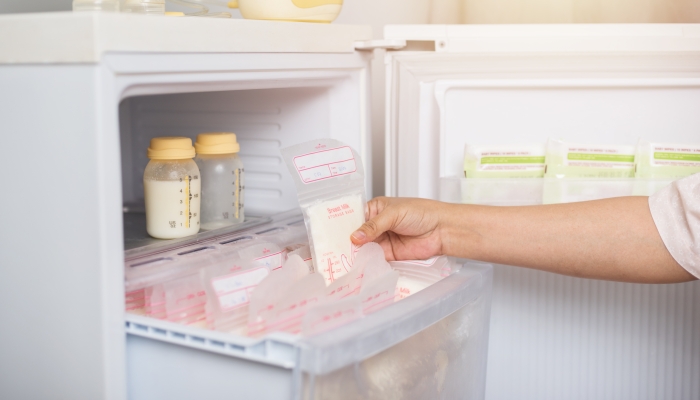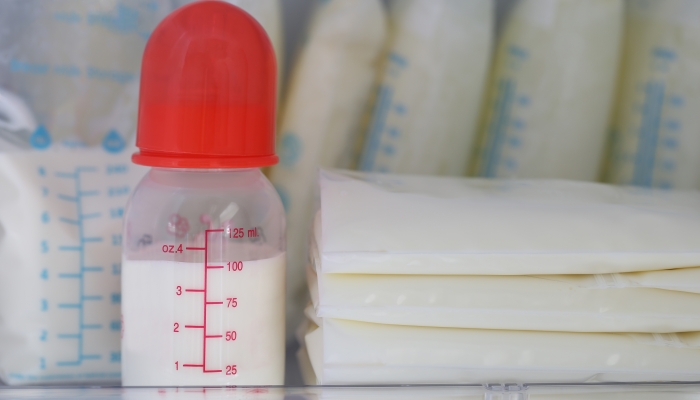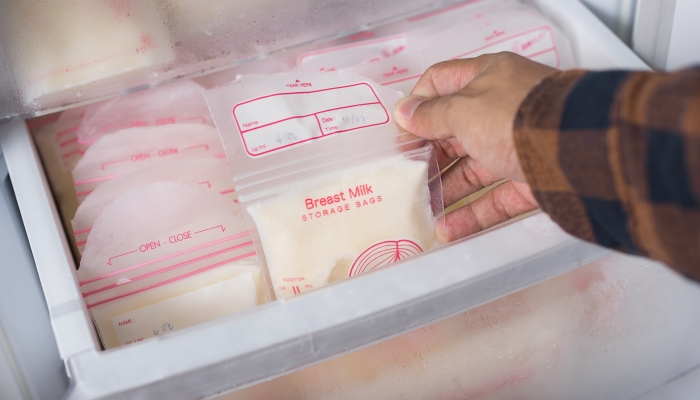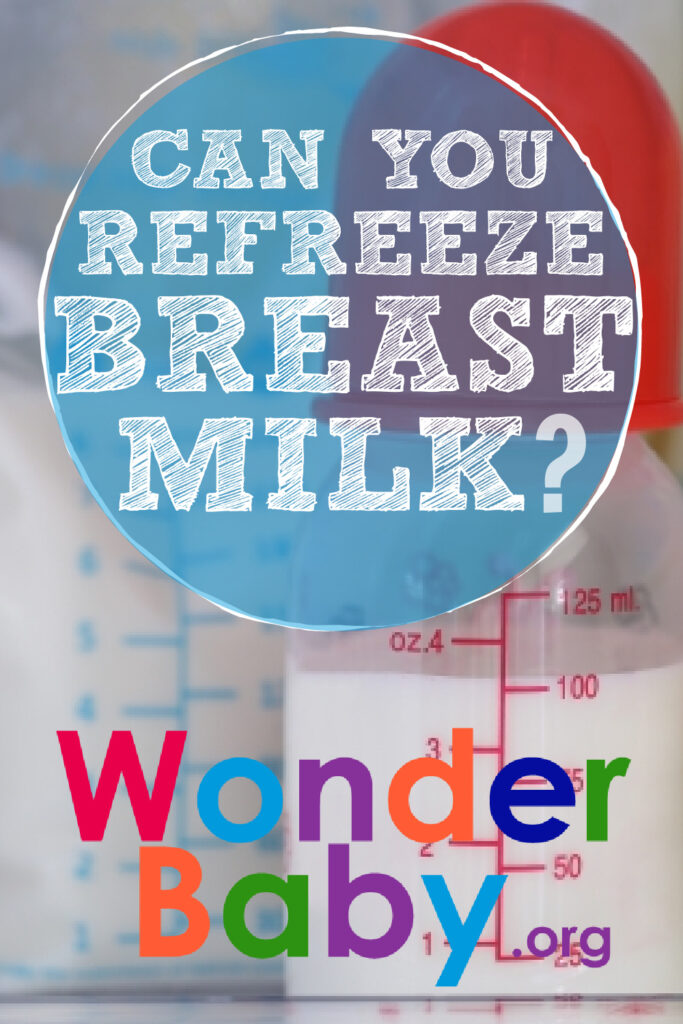Can You Refreeze Breast Milk?

- You can refreeze breast milk, but only under certain conditions.
- Your breast milk can’t have fully thawed and it can’t be leftover milk from a prior feeding if you want to refreeze it.
- If stored properly, freshly expressed breast milk can keep fresh for up to 12 months.
- Breast milk can be safely thawed and heated in multiple ways.
- If your thawed breast milk has a rotten taste, rotten smell, or discolored spots, throw it away.
Freezing your breast milk can be a great way to ensure you have multiple feedings for your baby. There may be situations, however, where you may desire to refreeze your previously frozen breast milk.
For example, your baby only had half of their bottle and you want to store that bottle for feeding later. Another example would be that your freezer lost power for a few hours overnight and all your frozen breast milk is now partially thawed. While you would hate to waste either the half-full bottle or freezer full of previously frozen milk, you don’t want to give your baby spoiled milk.
The good news is that you can safely refreeze breast milk, but only under certain conditions.
Why Should You Store Breast Milk?
There are plenty of reasons why you may choose to store breast milk for future feedings. Examples include:
- You have a sudden drop in milk supply.
- You are sick and temporarily on medications that could be passed on to your baby via breast milk.
- You desire to donate your breast milk to help feed infants in need.

How to Properly Store Expressed Breast Milk
There are several components to properly storing human milk. These components include location, temperature, and type of storage container.
Location and Temperature
When it comes to location and temperature, the colder the temperature, the longer you can store human milk. Below is a chart showing how long freshly expressed milk lasts in certain locations and the associated temperatures:
| Location and Temperature | Length of time |
| Countertop (Room temperature – up to 77 degrees) | Up to 4 hours |
| Refrigerator (40 degrees) | Up to 4 days |
| Freezer or Deep Freezer (0 degrees or colder) | Up to 12 months |
Storage Container Type
There are several types of containers for human milk storage. You could use glass bottles, hard plastic containers, plastic bags, or breast milk storage bags. Breast milk storage bags tend to store more compactly than bottles since they’re plastic, but they may be more expensive. The milk storage guidelines don’t change depending on the container you choose, thankfully.
Tips About Storing Breast Milk
Here are some tips to help make storing breast milk easier.
- Store breast milk in 2 to 4-ounce portions. This will help prevent wasting breast milk.
- Label your breast milk with the time and date that you stored it. This will allow you to ensure you are using your oldest milk first before it spoils.
- Ensure that you don’t have bubbles in your milk when you freeze your milk. Those bubbles will freezer burn your milk.
- Whatever container you store your breast milk in, make sure you don’t completely fill it up. Since breast milk expands when frozen, you’ll keep your containers from bursting!
How to Safely Thaw Frozen Breast Milk
Once you’re ready to feed your infant, you’ll need to thaw your frozen breast milk. There are several ways to do this.
Refrigerator Overnight Method
If you know how much thawed human milk you need ahead of time, you can use your fridge to thaw it. Just put your frozen breast milk into the fridge the night before and let it thaw. This method requires the thawed breast milk to be used within 24 hours.
If you don’t know how much you need that far ahead of time, there are quicker ways to do it.
Warm Running Water Method
You can take the container and run it under warm water until it thaws. This will take several minutes.
Warm Water Bowl Method
You could also thaw the container by setting it in a bowl of warm water until it thaws. Just know that you’ll need to replace the water frequently, as it’ll become lukewarm water quickly. With this method and the running water method, you need to use the thawed milk within about two hours of it thawing.
Avoid Microwaves and Boiling In Water
Microwaving and boiling containers in water may come to mind when you want to heat your completely thawed milk. However, microwaves and boiling water can create hot spots, which can result in scalding your baby’s mouth. They can also get the milk too hot and destroy nutrients.
Warming Thawed Breast Milk
Once the breast milk is thawed, you have the option to warm it up.
When you are warming up your breast milk, you will need to test it before serving it to your baby. To do this, simply put a few drops of the warmed breast milk onto your wrist. You’ll be able to tell if the milk is too hot before feeding your baby. This will save your baby from the possibility of unintentionally scalding them!

Is It Safe to Refreeze Breast Milk?
Refreezing breast milk, under the right conditions, can be done safely.
Once your breast milk has fully thawed, it can no longer be safely refrozen. If your milk is still partially frozen, you can still refreeze it. Partially frozen breast milk still has ice crystals in it and will not be fully liquid.
Leftover milk from a prior feeding can’t be refrozen. Once your baby has drunk from the bottle, that leftover breast milk will have contaminants in it that will cause bacterial growth. Even refreezing it won’t prevent it from spoiling.
Further, keep in mind that warmed breast milk has a window of time in which it needs to be used.
Signs That Stored Breast Milk Has Gone Bad
When breast milk goes bad, there are several signs to look out for. These include
- Rotten taste,
- Rancid smell,
- And discolored spots in the milk.
Breast milk has a different taste and smell when compared to cow’s milk. You can double-check to see if your breast milk has gone bad by doing a smell and/or taste test. If your breast milk tastes or smells like out-of-date cow’s milk, then you need to toss it. If you have reservations about the taste or smell of your breast milk, then go ahead and toss it.
If you notice dark, grey, or black spots in your breast milk, you need to throw it away. Those spots are mold that has started growing in your milk. If there are any other spots or discoloration you aren’t sure about, then go ahead and throw the milk away.
FAQs
Is it true that breast milk has all sorts of benefits for my baby?
Breast milk can positively impact your baby’s health, thanks to its unique makeup of proteins, fats, carbohydrates, and other nutrients. Breast milk is rich in calories, which helps your baby the energy to be playful and develop physically.
The American Pregnancy Association lists some ways breast milk helps your baby out, which include:
- Giving certain white blood cells antibodies you already have to your baby to help fight against infections
- Helping promote the growth of healthy gut bacteria
- Reducing the rate of certain chronic health problems, like diabetes, later in life
What are some uses for spoiled breast milk?
While spoiled milk isn’t safe for consumption, there are alternatives to throwing it out. Make sure the breast milk you are using doesn’t have a nasty smell to it, or it may be unsafe.
You can soothe sore nipples from breastfeeding or pumping by rubbing some breast milk onto them. Rinse the milk off your nipples before you pump or breastfeed again.
If you have irritated or dry skin, you can try relieving it by adding some of your spoiled breast milk to your tub bath. When you’re done with your bath, rinse yourself and dry off per usual.

The information WonderBaby provides is not intended to be, and does not constitute, medical or other health advice or diagnosis and should not be used as such. Always consult with a qualified medical professional about your specific circumstances.
Related Posts

Breastfeeding, Sleep
Sleep and Breastfeeding: A Comprehensive Guide for Nursing Moms
Many people assume breastfeeding and sleep training don’t go together, but it is possible to help your baby sleep better while continuing your breastfeeding journey.

Breastfeeding
Comfort Nursing: Pros, Cons, and How to Stop
Find out what comfort nursing is, when should you worry about it, and how to stop or limit your baby's comfort nursing (especially at night!).

Breastfeeding, Product Reviews
5 Best Breastfeeding Chairs for Nursing Moms of 2023
Whether you want a gentle rock, a smooth glide, or a cozy cuddle to soothe your baby to sleep, you’ll have your pick of the best breastfeeding chairs on the...